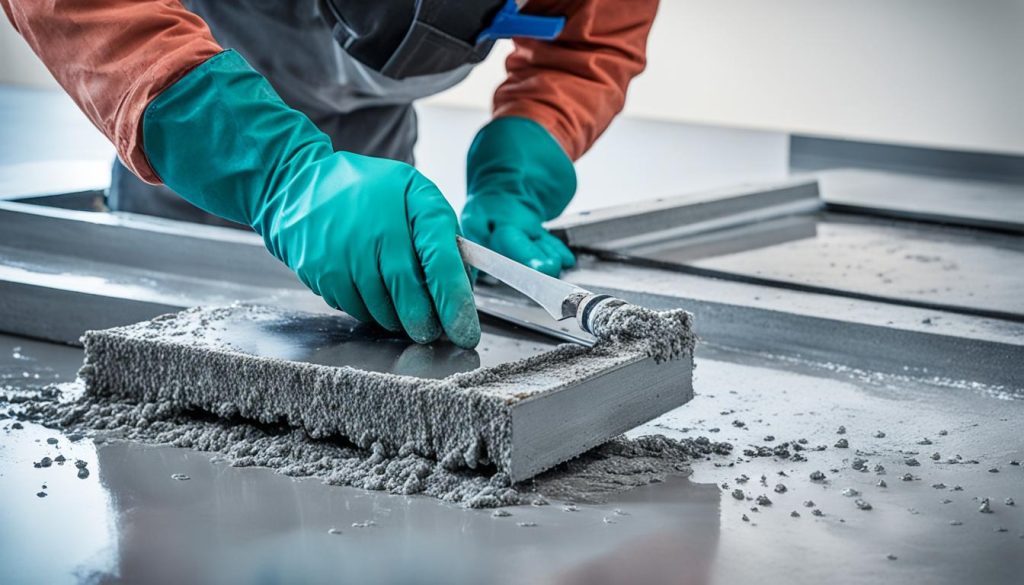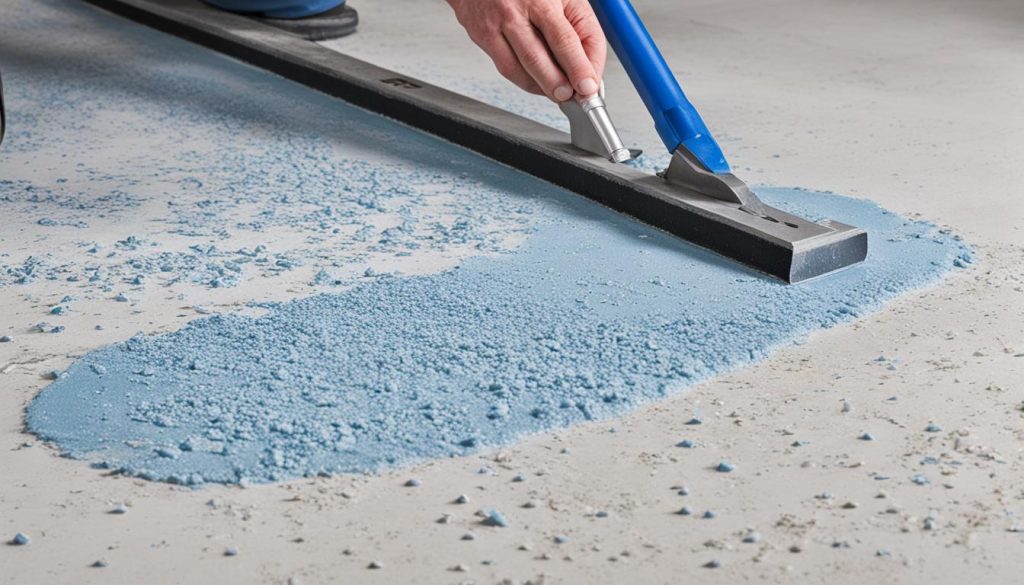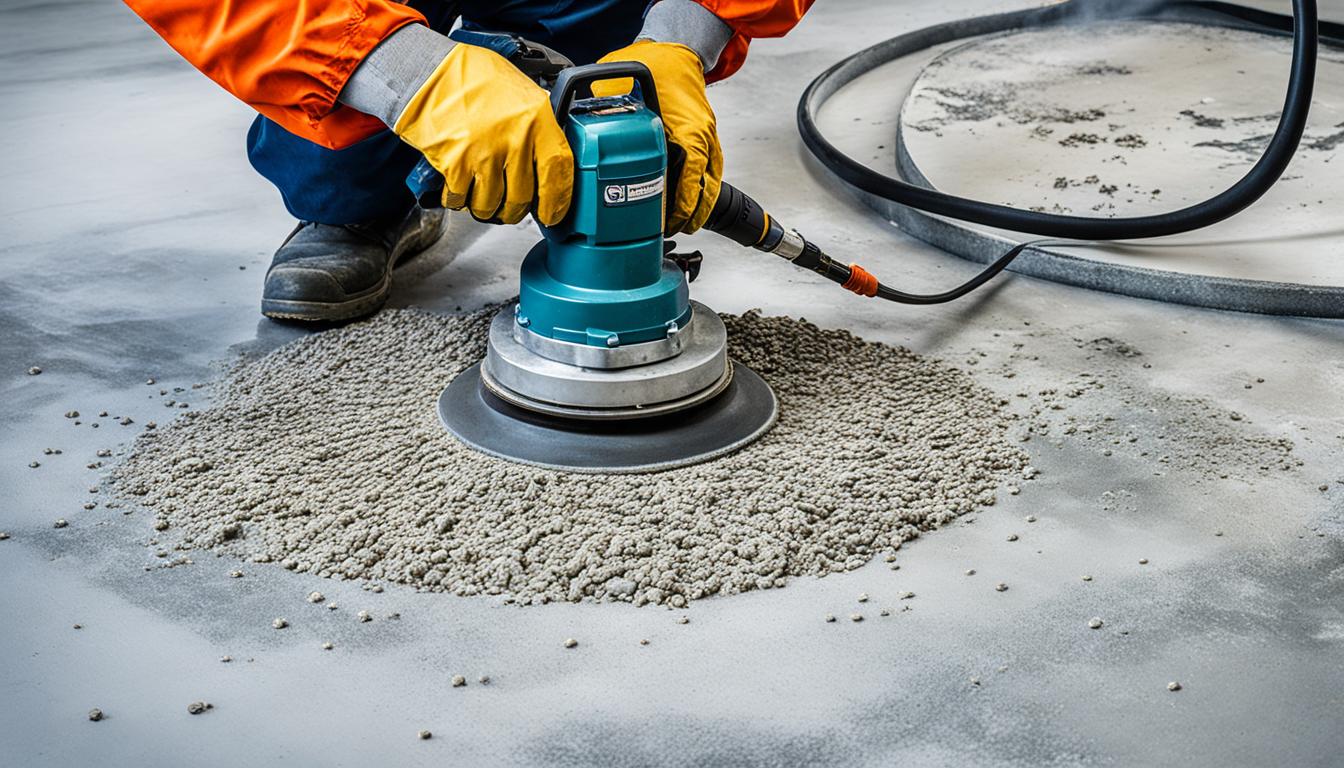Did you know that epoxy spills on concrete can be a major headache if not properly addressed? Whether you need to remove epoxy from a small surface or an entire floor, there are effective methods available to simplify the process.
Before applying epoxy, it’s essential to choose the right product for your needs. Selecting the appropriate epoxy can prevent spills and minimize the need for extensive removal. LePage Epoxy Steel is recommended for crack sealing and adhering metal to concrete, while LePage Gel Epoxy is ideal for vertical surfaces.
If you’re wondering how to remove epoxy from concrete, there are several techniques that can help. The method you choose depends on whether the epoxy is still in its liquid state or has already cured. Let’s explore these methods in detail.
Key Takeaways:
- Choose the right epoxy for easy removal and desired results.
- Remove epoxy before it cures using acetone or isopropyl alcohol.
- Scrape away cured epoxy with tools like a putty knife or chisel.
- Soften the epoxy with heat and acetone for easier removal.
- Use recommended products like heat guns, acetone, and isopropyl alcohol for epoxy removal.
Removing Epoxy from Concrete Before It Cures
If you need to remove epoxy from a concrete surface before it cures, there are several effective methods you can use. It is crucial to address epoxy spills on concrete promptly to prevent them from drying and hardening.
- Acetone: One of the most common methods for removing epoxy is using acetone. Soak a clean rag in acetone and gently rub it onto the epoxy spillage area. The acetone will dissolve the epoxy, making it easier to clean off the surface.
- Isopropyl Alcohol: Another effective method is using isopropyl alcohol. Similar to acetone, soak a rag in the alcohol and rub it onto the epoxy spill. The alcohol will break down the epoxy, allowing for easier removal.
After applying acetone or isopropyl alcohol, use a dry cloth or paper towel to clean off the liquid and residue. If needed, you can also use wet-and-dry abrasive paper to sand the area and blend it with the surrounding surface.
It’s important to note that when using any chemical solvents, always follow the manufacturer’s instructions and safety precautions. Wear protective gloves and work in a well-ventilated area.
To visualize the process, here’s a step-by-step guide on removing epoxy from concrete before it cures:
- Step 1: Prepare your materials and ensure adequate ventilation.
- Step 2: Soak a clean rag in either acetone or isopropyl alcohol.
- Step 3: Gently rub the soaked rag onto the epoxy spillage area.
- Step 4: Use a dry cloth or paper towel to clean off the liquid and residue.
- Step 5: If necessary, sand the area with wet-and-dry abrasive paper to blend it with the surrounding surface.
- Step 6: Dispose of any used rags or materials according to local regulations.
Remember, removing epoxy from concrete before it cures is easier and more efficient than dealing with cured epoxy. By following these methods, you can effectively clean up epoxy spills and maintain the appearance of your concrete surfaces.
Removing Cured Epoxy from Concrete
When it comes to removing cured epoxy from a concrete surface, there are several effective methods you can use. Let’s explore the step-by-step process.
- Step 1: Gather the necessary tools – a putty knife or chisel, a hammer (if needed), and a plastic scraper.
- Step 2: Begin by using the putty knife or chisel to scrape away the cured epoxy. Start at one edge and work your way across the surface, applying steady pressure.
- Step 3: If the epoxy is particularly stubborn, you may need to use a hammer to break it up into smaller pieces for easier removal.
- Step 4: To protect the concrete surface, it is recommended to use a plastic scraper instead of metal. This will help prevent any damage or scratches.
- Step 5: Before scraping, soften the epoxy by applying a combination of acetone and heat. Take necessary precautions, such as wearing gloves and working in a well-ventilated area.
- Step 6: Once the epoxy has been removed, use a rag and acetone to clean up any residue left behind.
With these steps, you can effectively remove cured epoxy from concrete surfaces, restoring the natural look of your floor or other areas.
For a visual reference, take a look at the image below:

| Tools/Ingredients | Quantity |
|---|---|
| Putty knife or chisel | 1 |
| Hammer | 1 (if necessary) |
| Plastic scraper | 1 |
| Acetone | As needed |
Now that you know how to remove cured epoxy from concrete, you can confidently tackle any epoxy removal project with ease and efficiency.
Choosing the Right Epoxy
Selecting the right epoxy is crucial when it comes to both achieving desired results and ensuring easy removal if necessary. By choosing the appropriate epoxy for your specific needs, you can minimize the risk of spills and eliminate the need for extensive removal processes. Two highly recommended epoxy options for different applications are:
1. LePage Epoxy Steel
If you’re looking to seal cracks or adhere metal to concrete, LePage Epoxy Steel is an excellent choice. This epoxy comes in a convenient syringe dispenser, making application a breeze. Once cured, it transforms into a strong metallic gray finish that is both durable and aesthetically pleasing.
2. LePage Gel Epoxy
In situations where vertical surfaces need epoxy application, LePage Gel Epoxy is a great option. This epoxy dries translucent in just six minutes, allowing for a quick and efficient process. Its gel consistency ensures easy application and adherence to vertical surfaces, making it ideal for various projects.
By selecting the right epoxy for your specific needs, you can save time, effort, and resources, while also achieving the desired results. Remember to follow the manufacturer’s instructions for proper application and curing to ensure the best outcome.

| Epoxy Brand | Recommended Uses | Features |
|---|---|---|
| LePage Epoxy Steel | Crack sealing, metal adhesion | Convenient syringe dispenser, metallic gray finish |
| LePage Gel Epoxy | Vertical surface applications | Dries translucent in six minutes, easy application |
Recommended Products for Epoxy Removal
When it comes to DIY epoxy removal, there are several recommended products that can make the process easier and more efficient. Chemical solvents such as acetone, isopropyl alcohol, and paint thinner are often used to soften the epoxy, making it easier to remove. These solvents can be applied to the epoxy surface and left to soak for a period of time, allowing them to penetrate and break down the epoxy bonds.
In addition to chemical solvents, another effective tool for epoxy removal is a heat gun. By applying heat to the epoxy, it becomes softer and more pliable, making it easier to scrape off. However, caution should be exercised when using a heat gun, as excessive heat can damage the concrete surface. It is important to follow the manufacturer’s instructions and use the heat gun in short bursts, keeping a safe distance from the epoxy.
When considering epoxy removal, it’s worth noting popular epoxy brands that offer reliable products. Brands like Loctite and UniBond are well-known for their quality epoxy solutions. Whether you’re looking to remove epoxy from concrete surfaces or tackle other epoxy-related projects, these brands offer a range of products that can meet your needs.
Remember, when attempting epoxy removal, always follow proper safety precautions and consider the specific requirements of your project. Whether you choose chemical solvents or a heat gun, selecting the right method and tools can ensure a smooth epoxy removal process that leaves your concrete surfaces clean and ready for the next project.
FAQ
How can I remove epoxy from concrete before it cures?
What is the process for removing cured epoxy from concrete?
How do I choose the right epoxy?
What products are recommended for epoxy removal?
Source Links
- https://www.unibond.co.uk/en/how-to/adhesive-how-tos/how-to-remove-epoxy-from-concrete.html
- https://www.lepage.ca/en/know-how/clean-up-product-removal/how-to-remove-epoxy-from-concrete-all-you-need-to-know.html
- https://www.loctiteproducts.com/en/know-how/build-things/how-to-remove-epoxies-from-concrete.html
